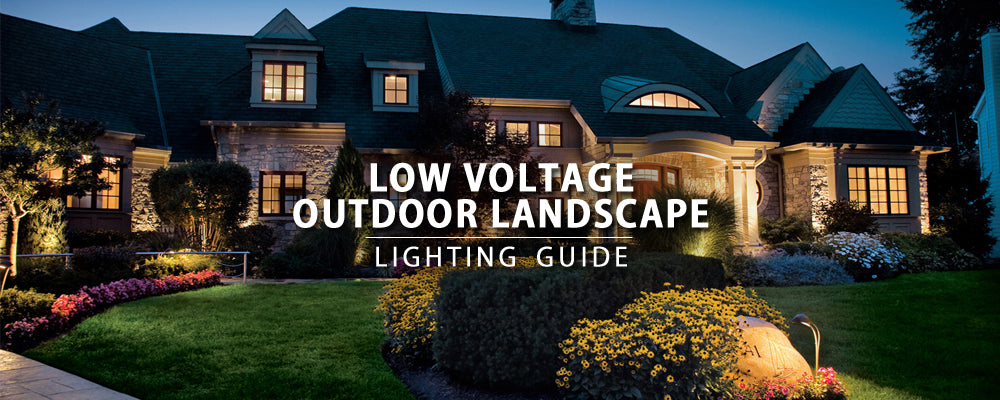
Low Voltage Outdoor Landscape Lighting Guide

Low voltage outdoor and landscape lighting is perfect for securing your property while making it beautiful. Utilizing the appropriate landscape lighting fixtures, you can easily highlight architectural features and landscape details. Low voltage outdoor lighting can also be combined with solar lights. This creates a complete lighting system with greater advantages in energy conservation, installation, and ease of use.
Low voltage systems consist of 3 components:
1. Transformer — Supplies the electricity
Transformers reduce household currents from 120-volts to a safe 12-volts or 24-volts. Automatic timers are also equipped in some transformers to allow lights to go on and off at preset times.
2. Low Voltage Cable — Transmits electricity
3. Low Voltage Lamp — Light source
Low voltage lamps offer more light, while using less energy.
Advantages of Low Voltage Lighting Systems |
||
 |
 |
 |
| Brightness | Greater Light Output | Power Source |
 |
 |
 |
| Easy Installation | Energy Efficient | Saves on Costs |
Choose Lamp Fixture
When choosing a light fixture, it is important to pick one that fits your needs—enhancing security, accenting landscape, highlighting architectural structure, etc. Learn about different types of lighting and their functionalities below.
 |
 |
 |
 |
 |
Decorative lighting for general use— gardens, pathways, trails, driveways. |
Illuminate pathways, walkways, trees, shrubs & flower beds. |
Markers to indicate the start or end of a path & illumination along walkways. |
Highlight trees, shrubs, statues, fountains or architecture. |
Lighting for decks, steps, fences and other wall mounted applications. |
 |
Downlighting
Place along walkways, steps, driveways and garden pathways to enhance safety. They are also great markers to signify the start and end of a trail or walkway. Add downlights to your patio or deck as accent lighting. |
 |
Uplighting
Perfect for creating a focal point and highlighting small trees, shrubs, fountains, and garden statues. |
 |
Backlighting
Enhance security by installing lights to illuminate walls, fences, and exterior of homes. Use them to accent trees and bushes to create depth and landscape design interest. |
Choosing a Transformer
When determining the appropriate transformer to use for your system, follow the following steps:
1. Choose Fixtures for Lighting System
All fixtures should be consistent in voltage—either all 12-volt or all 24-volt. Do not pair 12-volt lamps with a 24-volt transformer, the lamp will immediately burn out and potentially become a fire hazard.
2. Determine Type of Transformer
Low voltage transformer types include: 12-volt electronic transformer, 12-volt magnetic transformer, 24-volt electronic transformer, or 24-volt magnetic transformer. For outdoor applications, magnetic transformers are typically used, rather than electronic transformers, since they provide greater support and power to the light system.
3. Determine Transformer Wattage
Add up the individual bulb wattages of each fixture in the system. Then, find a transformer that fits your wattage need. Each transformer has a maximum wattage load—this is indicated on the product label. For electronic transformers, the maximum wattage load must be equal to or larger than the total wattage of all fixtures that will be connected. However, for magnetic transformers, the maximum wattage of the lighting system should not exceed 80% of the wattage load listed for the transformer.
Example:

|
4 x 18W Path Lights + 2 x 20W Bollards + 4 x 20W Flood Lights = 192W A 300W magnetic transformer will be needed for this system. Although the total wattage of the fixtures in the light system is under 200W, a 200W magnetic transformer should not be used because it exceeds 80% of the wattage load listed. |
Choose Cable Size
Refer to the chart below to determine the best cable size, or cable gauge, to use in your lighting system.
| Transformer Wattage |
Maximum Recommended Cable Length at Maximum Wattage Load | ||
| 16 Gauge Cable | 14 Gauge Cable | 12 Gauge Cable | |
| 45W | 100 ft. | * | * |
| 120W | 75 ft. | 100 ft. | 125 ft. |
| 200W | — | 75 ft. | 100 ft. |
| 300W | — | — | 75 ft. |
| 600W | — | — | 75 ft. each circuit |
| 900W | — | — | 75 ft. each circuit |
* Cable conductors may not fit in transformer terminals.
Tip! When creating cable runs, keep them short. Shorter runs allow for greater uniformity in light output for all fixtures connected to the transformer. As fixtures are placed at a greater distances from the transformer, the lower the voltage—or power—supplied, resulting in dimmer illumination.
The following are some of the most common low voltage cable layouts.
 Straight Run Straight Run
The most common method of cable wiring has the light fixtures run in a sequence directly from the transformer. |
 Split Load Split Load
Run up to the recommended maximum cable length in multiple directions from the power source. |
 “T” Wiring “T” Wiring
“T” method provides power to the center of the run or a run some distances away. This allows for more equal distribution of power and uniformity of illumination. Heavier gauged cables should be used in this wiring method.
|
 Split “T” Wiring Split “T” Wiring
Split “T” allows for a cable to run in multiple directions some distances away, while still providing uniform power distribution to both legs. |

Loop Loop installation provides greater uniform light output. With this method, wire polarity must be observed. |
Need more assistance? |
|
Have more questions regarding low voltage lighting, outdoor landscape lighting, technical support or installation help? Contact us at customerservice@lbclighting.com. |
